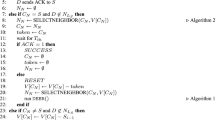Abstract
The quality of communication between any two users in multi-hop wireless sensor networks directly depends upon the path selection among the available paths between end-users. The issue of selecting the optimized path from source to a destination becomes the necessary criteria for effective communication between end-users. The art of work mainly focuses on the selection of the path which has the best available bandwidth however they do not consider other network parameters such as distance, energy, the intensity of traffic which plays a critical role in routing. In this paper, an algorithm is presented for the selection of optimized route from source to destination by considering different network parameters along with the bandwidth and rank is given to all the available routes from source to destinations per their weights. The paper is validated using network simulator.




Similar content being viewed by others
Data Availability
Not applicable.
References
Couto, D., Aguayo, D., Chambers, B. A., Morris, R.(2002) Performance of Multi-Hop Wireless Networks: Shortest Path is Not Enough, First Workshop on Hot Topics in Networks (Hot Nets-I).
Ahmad, S. J., Reddy, V. S. K., Damodaram, A., & Krishna, P. R. (2013). Location aware and energy efficient routing protocol for long distance MANETs. International Journal of Networking and Virtual Organisation,13(4), 327–350.
Preetha, M., & Sivakumar, K. (2018). An energy efficient sleep scheduling protocol for data aggression in WSN. Taga Journal,14, 404–414.
Zhao, Z., Kaida, Xu, Hui, G., & Liqin, Hu. (2018). An energy efficient cluster routing protocol for wireless sensor networks based on AGNES with balance energy consumption. Sensors,18(11), 1–27.
Tam, N. T., Hai, D. T., Son, L. H., & Vinh, L. T. (2018). Improving lifetime and network connections of 3D wireless sensor networks based on fuzzy clustering and particle swarm optimization. Wireless Networks,24, 1477–1490.
Amodu, O. A., & Mahmood, R. A. (2018). Impact of the energy-based and location-based LEACH secondary cluster aggregation on WSN lifetime. Wireless Networks,24, 1379–1402.
Qing, L., Zhu, Q., & Wang, M. (2006). Design of a distributed energy-efficient clustering algorithm for heterogeneous wireless sensor networks. Computer Communications,29(12), 2230–2237. https://doi.org/10.1016/j.com.2006.02.017.
Heinzelman, W., Chandrakasan, A., & Balakrishnan, H. (2002). An application specific protocol architecture for energy-efficient for wireless sensor networks. IEEE Transactions on Wireless Communications,1(4), 660–670.
Younis, O., & Fahmy, S. (2004). HEED a hybrid, energy-efficient, distributed clustering approach for ad hoc sensor networks. IEEE Transactions on Mobile Computing,3(4), 366–379. https://doi.org/10.1109/TMC.2004.41.
Lindsey, S., & Raghavendra, C. (2002). PEGASIS: Power-efficient gathering in sensor information systems. IEEE Aerospace Conference Proceedings,3, 1125–1130. https://doi.org/10.1109/AERO.2002.1035242.
Singh, R., Kumar, S., & Kathuria, A. K. (2019). Secure routing protocols for wireless sensor networks. ICCCA (pp. 1–5). IEEE: Piscataway.
Tao Yang, Xu, Xiangyang, L. P., Tonghui, Li, & Leina, P. (2018). A secure routing of wireless sensor networks based on trust evaluation model. Procedia Computer Science,131, 1156–1163.
Godder, T. K., Hossain, M. M., Rahman, M. M., & Miah, S. (2011). An efficient quality of service based routing protocol for mobile Ad Hoc network. International Journal of Computer Science Issues,8(3), 508–514.
Ahmad, A., Javaid, N., Qasim, U., Ishfaq, M., Khan, Z. A., & Alghamdi, T. A. (2014). RE-ATTEMPT: a new energy-efficient routing protocol for wireless body area sensor networks. International Journal of Distributed Sensor Networks,10(4), 464010.
Zaman, N., Low, T. J., & Alghamdi, T. (2015). Enhancing routing energy efficiency of wireless sensor networks. 17th International Conference on Advanced Communication Technology. Piscataway: IEEE.
Liang, H., Yang, S., Li, Li, & Gao, J. (2019). Research on routing optimization of WSNs based on improved LEACH protocol. EURASIP Journal on Wireless Communications and Networking,194, 1–12.
Julie, E. G., Tamilselvi, S., & Robinson, Y. H. (2016). Performance analysis of energy efficient virtual back bone path-based cluster routing protocol for WSN. Wireless Personal Communications,91(3), 1171–1189.
Medidi, S. R., & Vik, K. H. (2004). Quality of service-aware source-initiated ad-hoc routing. IEEE SECON Conference. https://doi.org/10.1109/SAHCN.2004.1381908.
Seada, K., Zuniga, M., Helmy, A., & Krishnamachari, B. (2004). Energy efficient forwarding strategies for geographic routing in lossy wireless sensor network. Proceedings of the 2nd International Conference on Embedded Networked Sensor Systems. https://doi.org/10.1145/1031495.1031509.
Koul, A., Patel, R. B., & Bhat, V. K. (2010). Distance and frequency-based route stability estimation in mobile Adhoc networks. Journal of Emerging Technologies in Web Intelligence,2(2), 89–95.
Ahmad, S. J., Reddy, V. S. K., Damodaram, A., & Krishna, P. R. (2012). Efficient Path Estimation Routing Protocol for QoS in Long Distance MANETs. ISDA 2012 (pp. 178–183). Piscataway: IEEE.
Funding
Not applicable.
Author information
Authors and Affiliations
Contributions
A simple and effective technique for routing is designed to improve the QoS in wireless sensor networks. Different parameters are taken into account instead of considering only a single parameter which improves the overall system performance.
Corresponding author
Ethics declarations
Conflict of interest
The author declared that there is no conflict of interest.
Additional information
Publisher's Note
Springer Nature remains neutral with regard to jurisdictional claims in published maps and institutional affiliations.
Rights and permissions
About this article
Cite this article
Alghamdi, T.A. Route optimization to improve QoS in multi-hop wireless sensor networks. Wireless Netw (2020). https://doi.org/10.1007/s11276-020-02388-y
Published:
DOI: https://doi.org/10.1007/s11276-020-02388-y




